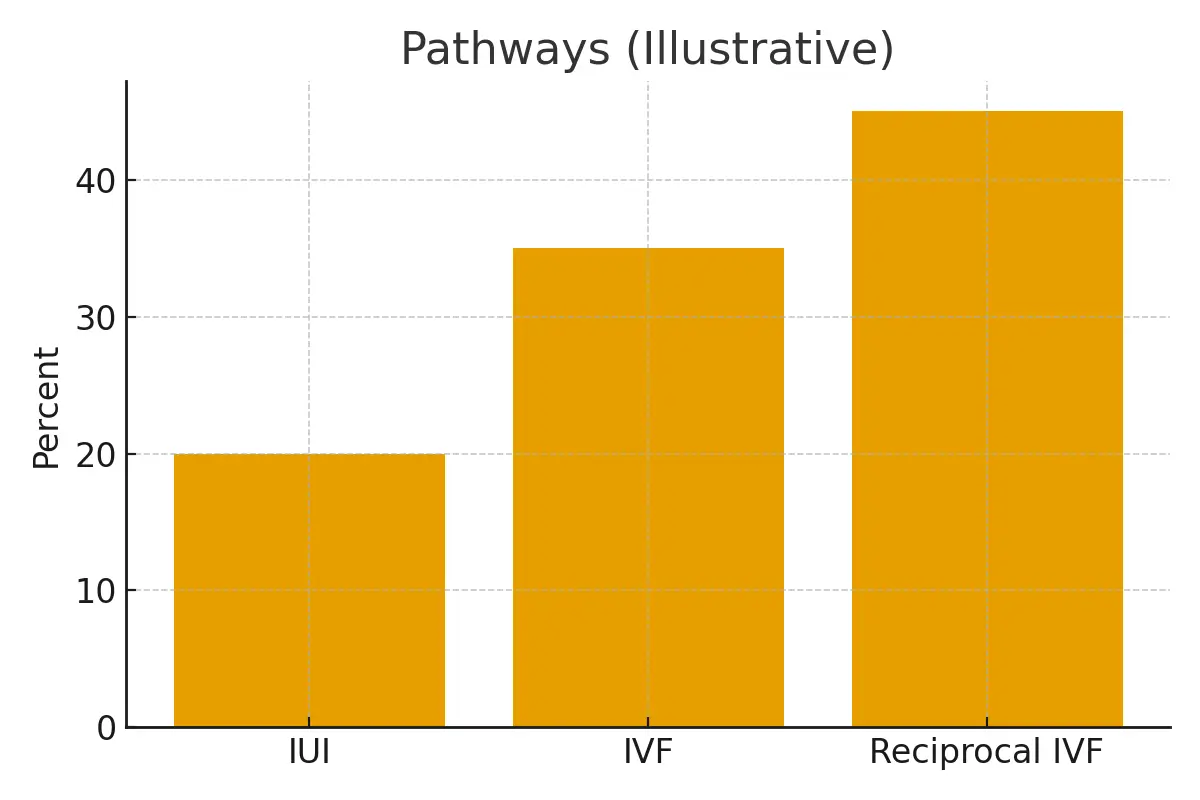
For lesbian couples and two-mom families, building a family today offers several medically supported pathways. Among the most common are Intrauterine Insemination (IUI), In Vitro Fertilization (IVF), and Reciprocal IVF. While they may sound similar, each path has unique differences in cost, complexity, and emotional meaning. This article breaks down where each method fits, what really changes outcomes, and how to align expectations around budget, timing, and results.
What It Is
- IUI (Intrauterine Insemination): Sperm is placed directly into one partner’s uterus during ovulation. It is the least invasive and most affordable option, though success rates are lower per attempt.
- IVF (In Vitro Fertilization): Eggs are retrieved from one partner, fertilized in the lab, and then embryos are transferred into the same partner’s uterus. It offers higher success rates, especially with age-related fertility decline.
- Reciprocal IVF (also called co-IVF): One partner provides the eggs, and the other carries the pregnancy. This allows both moms to have a biological and physical connection to the child.
Who It Helps
- IUI is best for younger couples (under 35), those with no known fertility issues, and those seeking a simpler, lower-cost entry point.
- IVF is best for couples where one partner has diminished ovarian reserve, blocked tubes, or when IUI attempts have failed.
- Reciprocal IVF is best for couples who want shared biological involvement: one as the genetic mother, the other as the gestational mother. It also helps when one partner has stronger egg quality but the other has a healthier uterus.
Not every pathway is right for everyone. Factors like age, fertility labs (AMH, FSH), ultrasound imaging, and ovarian response strongly influence which option is most efficient.
Step-by-Step
IUI
- Cycle monitoring (bloodwork and ultrasounds).
- Donor sperm prepared in the lab.
- Insemination at peak ovulation.
- Pregnancy test after ~2 weeks.
IVF
- Ovarian stimulation with medications.
- Egg retrieval under sedation.
- Fertilization with donor sperm.
- Embryo culture (3–5 days).
- Transfer to uterus.
- Pregnancy test after ~10–12 days.
Reciprocal IVF
- One mom goes through stimulation and egg retrieval.
- Fertilization with donor sperm.
- Embryo(s) transferred into the other mom’s uterus.
- Pregnancy testing and ongoing prenatal care.
Pros & Cons
IUI
- Lower cost, simpler, less invasive.
- Lower success per cycle, especially after age 35.
IVF
- Higher success rates, ability to test embryos, more control.
- Expensive, requires medications and surgery.
Reciprocal IVF
- Emotional benefit of shared motherhood, strong connection for both parents.
- Highest cost, requires more medications, legal clarity sometimes needed.
Costs & Logistics
- IUI: $500–$3,000 per cycle (excluding donor sperm).
- IVF: $15,000–$25,000 per cycle, plus medication and donor sperm.
- Reciprocal IVF: $20,000–$30,000+, since it involves stimulation and transfer for two people.
Important logistical considerations include:
- Insurance coverage – often limited for LGBTQ+ couples.
- Donor sperm – costs vary by source and storage fees.
- Legal documentation – especially for reciprocal IVF to secure both moms’ parental rights.
- Calendar alignment – syncing cycles for reciprocal IVF can affect timing and stress.
What Improves Outcomes
- High-quality donor sperm with proven motility.
- Thorough uterine evaluation before IVF or IUI.
- Choosing clinics with strong lab quality indicators.
- Protocol timing and calendar coordination.
- Mental health support to help couples manage stress.
- Transparent budgeting and escrow planning to reduce financial strain.
Case Study
A two-mom couple in their early 30s began with IUI due to its simplicity. After four unsuccessful attempts, testing revealed lower egg reserve in one partner. They pivoted to reciprocal IVF: one partner provided eggs while the other carried. With careful timing and embryo testing, their second embryo transfer led to a successful pregnancy. What started with uncertainty ended with clarity, thanks to open communication with their clinic and clear financial planning.
Mistakes to Avoid
- Starting with IUI without reviewing fertility labs.
- Underestimating costs of donor sperm storage and shipping.
- Overlooking legal contracts that protect both parents’ rights.
- Rushing into reciprocal IVF without considering emotional implications.
- Not preparing emotionally for multiple cycles if the first doesn’t succeed.
FAQs
Q . Which option is most affordable?
Ans : IUI is usually the most affordable, but its lower success rates mean multiple attempts may add up.
Q. How do we decide between IVF and reciprocal IVF?
Ans : Reciprocal IVF makes sense if you want shared biological involvement. Standard IVF may be more cost-effective if only one partner plans to carry.
Q . Can both partners be on the birth certificate?
Ans : Yes, but legal steps vary by state or country. A second-parent adoption or parentage order may still be needed for full protection.
Q . How many cycles does it usually take?
Ans : Many couples need more than one attempt. On average: 3–6 IUIs, 1–2 IVF cycles, or 1–2 reciprocal IVF cycles for success.
5. What are the success rates?
Ans : IUI: ~10–20% per cycle under 35. IVF: ~40–60% per cycle under 35. Reciprocal IVF follows IVF statistics, depending on egg quality and uterine health.
Want help choosing the best path for your family? Book a free 15-minute nurse consult, upload your labs for review, or request a personalized cost breakdown. The right choice today can save time, money, and stress tomorrow.

Dr. Kulsoom Baloch
Dr. Kulsoom Baloch is a dedicated donor coordinator at Egg Donors, leveraging her extensive background in medicine and public health. She holds an MBBS from Ziauddin University, Pakistan, and an MPH from Hofstra University, New York. With three years of clinical experience at prominent hospitals in Karachi, Pakistan, Dr. Baloch has honed her skills in patient care and medical research.
- Dr. Kulsoom Baloch
- Dr. Kulsoom Baloch




